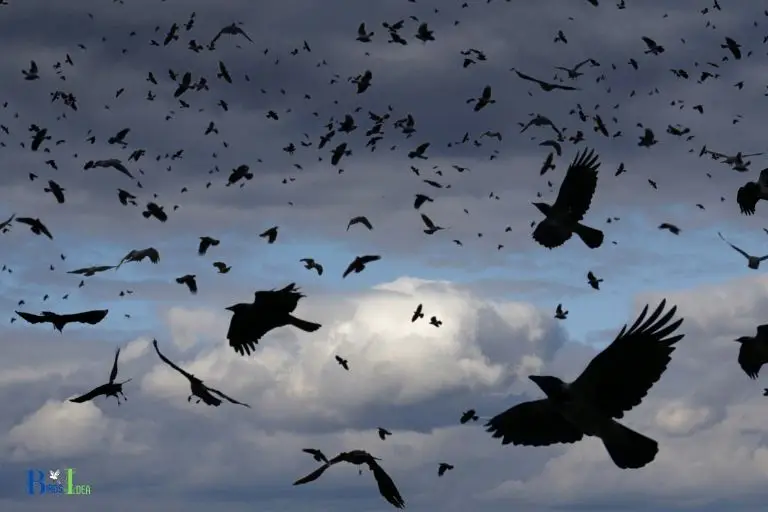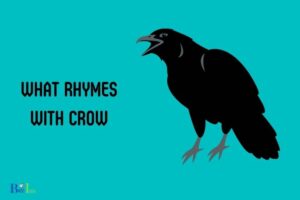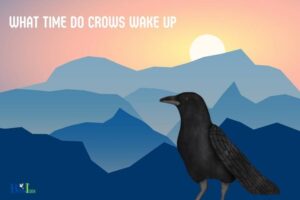What Time Do Crows Come Out? During the Day!
Crows are primarily diurnal birds, meaning they are most active during the day. They usually venture out at dawn and return to their roosts at dusk.
Crows are intelligent creatures that rely on daylight for many of their activities. Their tendency to operate from dawn till dusk aligns with the natural availability of food sources which are also most active during these hours.
While crows may seem ubiquitous due to their adaptability, each crow has its own schedule influenced by factors such as local climate conditions, predation pressure, food availability, and seasonal changes.
Therefore, while it’s common to see them active during daytime hours, the exact timing may shift throughout the year.

Understanding The Behavior Of Crows
Crows have fascinated people for centuries. These intelligent birds are known for their unique behavior and remarkable intelligence.
One of the most common questions asked by people is, “what time do crows come out? ” Understanding the behavior of crows can help us answer this question.
The Daily Routine Of Crows
Their daily activities include:
- Flying to forage for food
- Building nests
- Communicating with their family members through vocalizations
- Playing with objects or each other
- Performing social behaviors such as grooming
- Roosting at night
Factors That Influence The Behavior Of Crows
- Food availability: Crows are omnivorous birds, feeding on insects, grains, fruits, and small vertebrates. They tend to be more active during times of the day when food is readily available.
- Time of year: During the breeding season, crows are usually more active and vocal, establishing territories and attracting mates.
- Environmental factors: Crows are known to adjust their behavior to their environment. For example, they may congregate near areas of human activity, such as food waste disposal sites or parks.
- Social interactions: Crows are highly social birds that often move in large groups. Social dynamics, such as the presence of dominant individuals or the formation of family groups, can affect their behavior.
- Predation risk: Crows are aware of potential predators and adjust their behavior to minimize risk. For example, they may be less active and more cautious in areas with high predator density.
The Time Of Day When Crows Are Most Active
Crows are fascinating creatures with a distinct intelligence and complex social behavior. If you’ve ever wondered about the time of day when crows are most active, then you’ve come to the right place.
The Natural Habits Of Crows
- Crows are early risers, and they are usually most active during the day.
- They are scavengers and omnivores, feeding on a variety of food sources, including insects, small animals, fruits, and nuts.
- Crows are monogamous birds that mate for life and develop strong bonds with their partners.
- They are also highly territorial, defending their nests and territories from other crows and predators.
Morning Crow Activity
In the early morning hours, crows can be seen leaving their overnight roosting sites and heading out to search for food.
Here are some interesting points about morning crow activity:
- Crows are most active during the first few hours after sunrise.
- They often congregate in large groups and move in a coordinated manner when searching for food.
- They are known to use tools to obtain food, such as using sticks to extract insects from tree bark.
Afternoon Crow Activity
- They typically take midday breaks from foraging and may rest in trees or on utility wires.
- They may engage in social activities, such as grooming each other and playing games.
- Crows may also engage in territorial disputes and vocalize to defend their territory.
Evening Crow Activity
As the day winds down, crows become more active again.
Here are some interesting facts about evening crow activity:
- They are known to form large communal roosts at night, sometimes numbering in the thousands.
- Communal roosting provides crows with safety in numbers and warmth during cold weather.
- They may engage in social vocalizations and play games before settling down for the night.
Night-Time Crow Activity
Crows are not usually active at night, but there are some interesting behaviors to note.
Here are some key points:
- Crows may occasionally leave their roosts at night to forage for food or investigate potential threats.
- They use vocalizations to communicate with each other, even in the darkness.
- They have excellent night vision and can see well in low light conditions.
Crows are fascinating creatures that display complex social behavior and intelligence. Understanding their natural habits and daily behavior patterns can provide a glimpse into their world.
Whether you’re an avid birdwatcher or just curious about these intelligent creatures, take the time to observe and learn more about their fascinating lives.
Seasonal Differences In Crow Activity
Crows, known for their distinctive black feathers and intelligence, are common in North America and display varying activity patterns throughout the year based on the season.
Summer Crow Activity Patterns
In the summer, crows are active from dawn to dusk, exhibiting the following patterns:
- Active during the early morning and late afternoon hours.
- Spend most of the day searching for food and exploring their territory.
- Use vocalization to communicate with their mates and other crows.
- Roost earlier in the evenings compared to other seasons.
Winter Crow Activity Patterns
In the winter, crow activity patterns change drastically. Depending on the region, they may migrate to warmer climates or stay in their local area.
- Generally more active during the daytime due to shorter days.
- Spend more time searching for food sources as the number of available resources decline.
- Have to deal with the harsher temperatures and may need to roost together for warmth.
- More vocalization and socialization with other crows as they stay in larger groups for protection.
Spring Crow Activity Patterns
- More vocalization and socialization with other crows as they search for mates.
- Spend more time building and maintaining their nests.
- Use their vocalization to express territorial claims and attract a mate.
- Roost later in the evening as the days are longer.
Fall Crow Activity Patterns
In the fall, crows prepare for the colder weather ahead. They often form large groups and can be seen in huge numbers.
- Roost earlier in the evening as the days become shorter.
- Spend more time stocking up on food and searching for resources.
- Form large groups for protection and warmth during the winter months.
- More vocalization and socialization as they search for mates and solidify their territories.
Reasons Why Crows Are Active At Certain Times
Crows are highly intelligent birds, and their behavior is closely tied to the time of day. Some people wonder what time of day crows come out the most, or why they are more active at certain times.
Food And Feeding Habits Of Crows
Crows are omnivorous birds that feed on a wide range of food, including insects, fruits, nuts, seeds, and small animals. They are also known to scavenge on carrion, garbage, and human food.
Crows primarily feed in the early morning and late afternoon, but they can forage throughout the day, adjusting their feeding habits based on their surroundings and food availability.
- Crows have a diverse diet that includes insects, fruits, nuts, seeds, and small animals.
- They feed early in the morning and late in the afternoon.
- Crows adapt their feeding habits to their environment and food availability.
Roosting, Sleeping, And Resting Habits
Crows utilize communal roosts in winter to conserve heat and evade predators. While they are diurnal and typically rest at night, they may also rest during the day, especially in hot weather.
- Crows have communal roosting behavior.
- They use communal roosts to conserve heat and avoid predators.
- Crows usually rest during the night, but they may also rest during the day.
Nesting And Breeding Habits
Crows are monogamous birds that form long-lasting pair bonds. They build their nests in trees, usually near water sources or in open spaces.
Crows typically breed once per year, during the spring. They lay 3-9 eggs per clutch, which hatch after 18-21 days.
Crow chicks fledge after 4-5 weeks and become independent after about 2 months.
- Crows are monogamous and form long-lasting pair bonds.
- They build their nests in trees, usually near water sources or in open spaces.
- Crows breed once per year during the spring, and lay 3-9 eggs per clutch.
Social Behavior And Calls
Crows are social birds that communicate with a wide range of calls, including alarm calls, begging calls, and contact calls.
They also use visual displays, body postures, and gestures to communicate with each other. Crows are highly territorial birds that defend their feeding and nesting areas aggressively.
They may also form cooperative groups to defend their territories or food sources.
- Crows communicate with a wide range of calls and visual displays.
- They are highly territorial birds and defend their feeding and nesting areas aggressively.
- Crows may form cooperative groups to defend their territories or food sources.
Understanding the reasons why crows are active at certain times helps us appreciate these magnificent birds and their behavior.
By observing their food and feeding habits, roosting, sleeping, and resting habits, nesting and breeding habits, and social behavior and calls, we can gain a greater insight into their lives and habitats.
Conclusion
Overall, understanding when crows come out is important for those curious about the behavior of these intelligent birds.
Crows’ activity levels vary by location and season, but typically they are most active in the early morning and late afternoon.
These birds have a complex social structure and communicate with each other using a variety of calls and body language.
While they may be viewed as pests by some, crows play an important role in ecosystems by helping to control pest populations and recycling carrion.
Observing these birds in the wild can provide a fascinating glimpse into their world, and can also be a great opportunity for birdwatchers to add to their life lists.
So, the next time you find yourself wondering what time crows come out, take some time to observe these intelligent and fascinating creatures in action.






